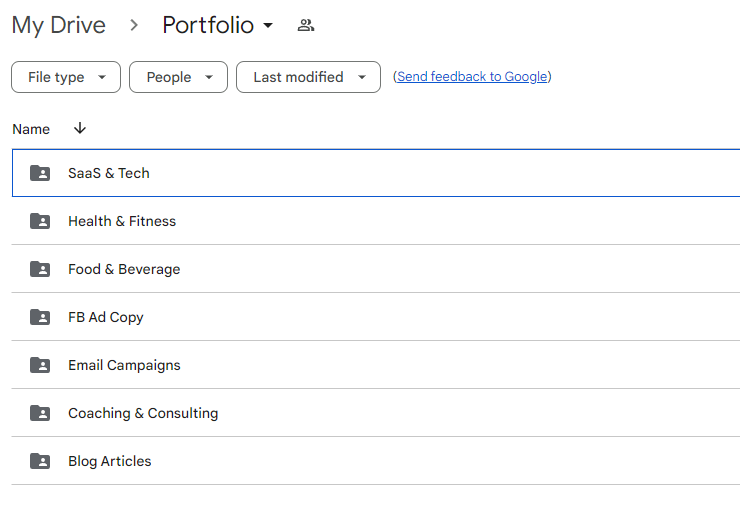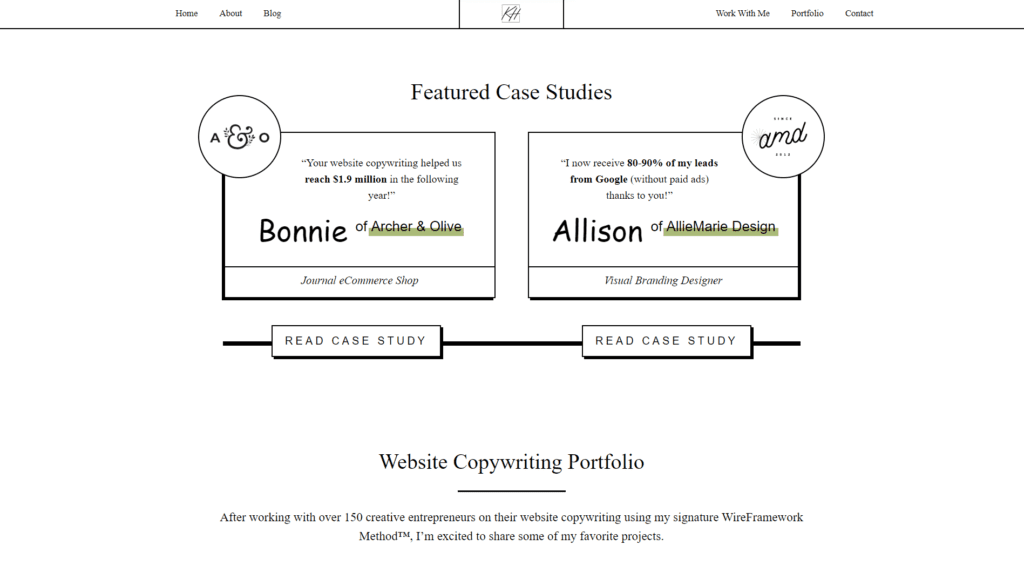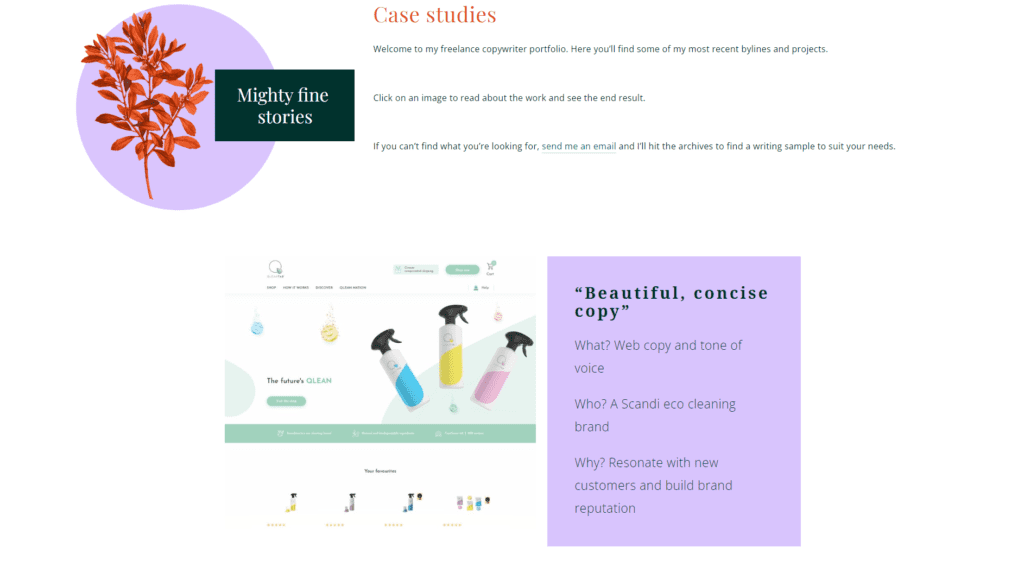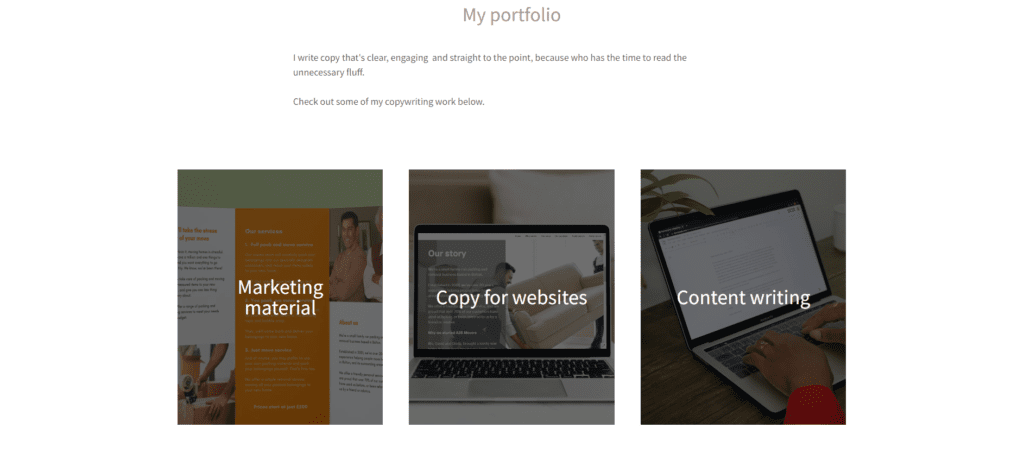Why does no one ever tell you how hectic “mom life” is? Ok, maybe they do… But between cleaning up spills, doing endless loads of laundry, and trying to scrounge up dinner with whatever’s left in the fridge, it’s not easy to find the time and energy to pursue your passions and build a successful freelance writing career. But if you’re a writer at heart, there’s no reason why you can’t turn your love of words into a thriving freelance writing business (even if you’re working from home with little ones underfoot).
Creating a professional freelance writing portfolio is an essential step in establishing yourself as a serious writer and attracting potential clients. Here are 7 practical steps to help you whip up a simple and attractive portfolio so you can start getting paid, mama!
Step 1: Identify Your Freelance Writing Niche
You’re a busy mom, right? That means there’s no time to waste throwing spaghetti at the ceiling to see what sticks… You need to create a freelance writing portfolio that:
- Is quick and easy to put together
- That will bring a steady stream of clients to your doorstep
To do this, you need to choose a writing niche that is in demand. Finding a niche that fits your interests and past skills will save you time, stress, and effort because you can quickly show clients what you are capable of.
For example, if you have a degree in nutrition and love to cook, you could focus on writing about food and healthy living.
This will help you focus your portfolio and pitch yourself to potential clients more effectively. You’ll know exactly who to target and how you can help them (vs. trying to write anything for anyone).
To find your niche, start by making a list of your areas of expertise and interests. Consider:
- What kind of writing you enjoy…
- What you’re most passionate about…
- What writing niches are in demand…
Once you identify your niche, you’ll be able to create a targeted portfolio that showcases your skills and experience.
This will give you more power to charge higher rates because you’ll be seen as an expert writer for this niche. You’ll be intimately familiar with the pains and passions of that audience, trends in that market, problems and solutions for that industry, and ways to provide value. And you can bet your clients will love that!
If you need more guidance on choosing a freelance writing niche, plus a list of the most in-demand niches for writers right now, check out this blog post.
Step 2: Choose a Type of Writing to Specialize In
Just like choosing a niche, focusing your efforts on one specific type of writing is a faster path to success. This makes you a specialist, not a generalist, and that can help your writing stand out from the competition.
There are so many different types of writing to specialize in:
- Website copy
- Blog posts
- Emails
- Digital ads
- Social media captions
- And about a dozen other types!
Here’s a blog that gives 13 different examples of freelance writing projects and how to get paid for them.
Once you’ve chosen one to focus on, it’s important to learn just enough about it to be dangerous… (a.k.a. enough to be able to write competently in that style). Every type of writing above has its own set of rules and conventions, so there’s plenty to learn for each one.
Side note: DON’T get stuck here… You don’t need to be the world’s greatest expert in writing whatever type you choose. Just enough knowledge so that any potential clients or editor can trust your ability to write it well and get results. You’ll learn as you go, and some of your best learning will happen in “trial by fire” situations.
Once you’ve chosen one or two types of writing to specialize in, showcase that in your portfolio. This means selecting writing samples that demonstrate your skills and experience for that specific type of writing.
For example, if you’re specializing in website copy, you might include “home,” “about,” and “service” pages. And maybe those pages would be Search Engine Optimized (SEO) with keyword-rich headlines and an engaging meta description to show potential clients that you understand what ranks in Google and how to make it happen.
Step 3: Build Your Skills While Building Your Freelance Writing Portfolio
If you’re just learning how to become a freelance writer, the writing samples you choose for your portfolio don’t need to be real published projects. When I first started, I created “spec” samples so I could show potential clients my writing style and what I was capable of.
Spec stands for “speculative” which just means they are mock projects that you create to show what you can do. Basically, you’ll pick a real brand or make one up, and then give yourself a brief to follow and complete the fake project.
To build your writing portfolio as quickly and easily as possible, you can just write this spec piece in a Google Doc. If you want to get a little fancier, you can use Canva templates to mock up what a project might look like when it’s done (like a website page or an ad).
Spec work is a great way to practice your writing while also creating portfolio pieces you can use to get paid writing gigs.
I believe in an “earn as you learn” approach to freelance writing. So don’t waste a ton of time making dozens of portfolio pieces you haven’t been paid for. Build 2-3 writing samples, learn some skills along the way, and then start cold pitching for paid projects. As you land clients and complete paid projects, dump the spec pieces and replace them with new stuff.
Step 4: Select Your Best Writing Samples
Your portfolio is like a resume; it needs to demonstrate the way you write and your level of expertise in your chosen niche or type of writing. You don’t want to include every piece under the sun that you’ve ever written to do that…
Less is more — just select your absolute best work. 2-3 pieces is just fine if you’re new to freelance writing.
When deciding which writing samples to include in your portfolio, ask yourself:
- Am I proud of this piece?
- Does it showcase my writing style and skills in a clear way?
- Does it represent the kind of writing I want to get paid to do?
- Will potential clients or editors get an accurate impression of what I can do from this sample?
That last question is key. You want to make sure you’re not over-promising or underselling yourself. Choose the pieces that demonstrate your true level of skill.
Here’s a handy little checklist to help you decide on the right writing samples for your portfolio:
- Quality: Choose writing samples that are well-written and error-free. Run it through Grammarly or ProWritingAid (both have free versions) and do a plagiarism check to make sure it’s 100% unique.
- Relevance: Choose writing samples that are relevant to your chosen niche and the type of writing you want to do. Blogs, headlines, and print ads all have very different styles and formats, so make sure yours represent the type of writing you want to get paid to do.
- Quantity: You don’t need more than 5-7 writing samples in your portfolio. Don’t overwhelm potential clients with too much work, and keep it focused on what they’re hiring you for.
- Variety: Choose writing samples that showcase your range of skills and styles. Different brands have different voices and different goals, so even if you’re sticking to one niche, you want to show that you can adapt to the needs of your client.
- Length: Consider the length of your writing samples. Most clients won’t take the time to read a 5,000-word article, so give them enough to get an accurate impression, but not so much that it’s overwhelming.
- Results: Proof is powerful. If your work is tied to numbers, stats, or other data that proves it can achieve the desired outcome for a client, lead with that!
Once you’ve chosen the best writing samples, it’s time to build out your portfolio.
Step 5: Gather Your Writing Samples in One Place
Okay, so you have at least 2-3 writing samples… But when you think of creating a freelance writing portfolio, a little panic probably sets in:
“I’m going to have to create an entire website, right?”
“I’ll need design skills, coding skills… and more money than I have!”
Actually, no! You don’t have to create a website (although it’s definitely an option, and we’ll talk about that below). But there are plenty of other options that are wayyy easier and more affordable. And they will still help you land freelance writing gigs.
Let’s start with my favorite (and the easiest option): Google Docs.
Most of your potential clients will be familiar with Google Docs, so this is a great option for presenting your writing samples. All you need to do is gather the writing pieces you want to showcase in one place (folder). The content can either be written directly on the document, or you could include a link to the live page (if it’s published somewhere online).
If your portfolio pieces are only available offline (like if they were printed in a magazine or newspaper), then you’ll need to scan them and upload the images to your Google Drive folder.
Or, if you created spec pieces for your portfolio in Canva, you can just upload the PDFs into your folder.

Thoughts on How to Organize Your Writing Portfolio
Generally, a potential client will want to see pieces that are relevant to their needs. Whether you’re going the Google Doc route or one of the other options that I’ll discuss below, it’s best to separate each folder by:
- Type of Writing (blogs, web content, copywriting, etc.)
- Industry (healthcare, finance, tech, etc.)
This is especially important if you’re going the generalist route at first, so you can easily point people to samples that are relevant to their products or services.
Title each piece with an appropriate name, and include a two-sentence description that explains what it’s about, what it was for, any successful results, or a client testimonial.
Then, when potential clients ask for your portfolio, simply share the appropriate folder or document with them.
Nothing fancy – but it will give them a chance to check out your writing style, knowledge of the industry, and how you structure your copy. Plus it’s super quick and easy for you to set up and start earning money as a freelance writer!
This is how I started and, even though I do have a writer’s website, I still use Google Docs to showcase my writing samples from time to time. And it’s been more than enough to get clients on board with hiring me!
Free Portfolio Websites for Freelance Writers
If you’re looking for something more professional or want to be able to further showcase your skills and achievements, there are also free portfolio websites that are simple to use:
- Contently
- Clippings.me
- Journo Portfolio
If you want to create a website, platforms like Wix and WordPress also have free options. I personally use Wix and find the drag-and-drop features very helpful in creating a portfolio that impresses quickly and easily.
Maybe I’m dumb, but having to install themes and plugins on WordPress makes me want to pull my hair out…
But not with Wix! There are beautifully designed templates to choose from and all the features you need to create a professional-looking portfolio in minutes.
Of course, free options come with certain limitations, so you may want to invest in better features (like adding your own custom domain name or removing the platform advertising icons).
On Wix you can upgrade for a custom domain, remove ads, increase storage, and even add payment processing if you want clients to be able to book and pay for your freelance writing services online — not only are these upgrades affordable, but they constantly run special deals. I don’t think I’ve ever paid full price for my Wix website.
Overall, I think Wix gives you a professional look, that’s quick to create, and won’t break the bank. But you can also explore other options if that doesn’t seem like the right fit for you.
No matter which route you choose for creating your freelance writing portfolio, what’s most important is that it reflects the type of work you want to be hired for.
Step 6: Create an Online Presence to Promote Your Freelance Writing Portfolio
So now that you’ve chosen a platform and organized your portfolio, the next step is to get your work seen! It’s not enough to just have a freelance writing portfolio – you need people to actually find it. And that means creating an online presence.
The Best Social Media Platform for Writers
Which social media platform is best for writers? For freelance writers, LinkedIn, Twitter, or Instagram are the best places to start. Each one has its own benefits and can be used to reach different types of clients. The platform you select should depend entirely on where your potential clients hang out.
Because my ideal clients (marketing professionals in the construction industry) are more active on LinkedIn, I focus all my effort and energy there. This has resulted in me becoming a six-figure freelance writer (here’s how I did that). I talk in detail about my LinkedIn strategy here. And really, this LinkedIn Strategy can be adapted to any social platform.
Because you’re a busy mom like me, I recommend:
- Picking just one platform (LinkedIn, Instagram, or Twitter)
- Setting it up well (i.e. professional headshot, link to your portfolio or website, a well-written bio, etc.)
- Being really consistent (spend a little time each week being active — posting helpful advice, sharing a win, engaging with other professionals in your chosen industry, etc).
Big tip: Don’t burn yourself out trying to be everywhere at once or posting every single day…
(That’s right! You DON’T have to waste tons of time coming up with dozens of posts each month!)
Instead, just focus on consistency. If you know you can only commit to one post a week, then do that. If 15 minutes on Tuesdays is all you can spare for commenting on other people’s posts, then stick to it.
The goal is to become a known and respected figure in your chosen industry. That takes time and consistency.
Want my high-success, low stress method for landing clients on LinkedIn? Click here.
Okay, now — how does your freelance writing portfolio fit in with your online presence? If someone is interested in working with you, the goal is for them to be able to check out your best work quickly and easily. So creating your writer portfolio and then promoting it via your social media platform is a good way to get your name out there.
Once again, this doesn’t have to be complicated! Just make sure that you link to your portfolio in your bio and occasionally create posts that showcase pieces from it or directs people to go check it out.
What if I hate social media?
I feel ya! Social media isn’t for everyone and that’s totally okay.
If social media isn’t your cup of tea, there are other ways to get the word out about your freelance writing services. You can:
- Cold email potential clients
- Join and participate in online forums
- Contact your local newspaper or online trade journals for your industry to contribute articles
- Or even just ask around – you’d be surprised at the number of people who refer gigs to friends
I just find that, because pretty much everyone is on social media, it’s a fast track to finding freelance writing clients.
Do you need a blog as a freelance writer?
As you become more immersed in the freelance writing world, you might find that many of your peers have blogs. So do you need a blog in addition to your freelance writing portfolio?
In short: it depends.
A blog, like your portfolio, can be a great way to showcase your writing ability and knowledge of an industry. You can share your blog on your social media too, so it can help with building an audience there. It can also help your website rank higher in Google and increase organic search traffic.
But it’s important to remember that writing a blog takes time. And as a busy mom, you may not have the extra hours to devote to creating content regularly. If you don’t have the time or energy to dedicate to consistently writing blog posts, then there’s no need to add yet another thing to your plate.
For me personally, I tried to start a blog on my website but didn’t stick with it. Plus, I found that I was able to get plenty of freelance writing gigs without the need for this extra effort. So I’ve just stuck with my LinkedIn strategy instead.
To sum up this point, having a blog as a freelance writer can help you land clients, but it’s certainly NOT necessary.
In today’s digital age, it’s important to have an online presence as a freelance writer. This starts with having a portfolio that showcases your best work and continues with having a presence on at least one social media platform. And if you have the time and energy to commit to regularly writing blog posts, it can be a great addition — helping you reach more potential clients while also building an audience for your freelance writing business.
Want to know the FASTEST way to write a blog post? Click here.
Other Ways to Leverage Your Portfolio
Beyond linking to your portfolio on social media or ranking it through a blog on your website, there are other ways to leverage your portfolio. Here are a few ideas:
1. Cold email: Many freelance writers land clients by sending cold emails. When you do this, make sure to include a link to your portfolio in the signature or body of the email so that potential clients can easily click it and see some of your best work.
2. Referrals: As you start to build relationships with other writers, editors, and clients, they may be willing to refer you for gigs or help spread the word about your services. In this case, make sure to give them easy access to your portfolio so they can quickly share your work for you.
3. Job boards: Many freelance writing job boards like these allow you to link to your portfolio in the description section when applying for gigs. This will help potential clients get an understanding of your writing style and ability quickly when you submit to projects.
4. Networking events: If you attend networking events related to freelancing, be sure to bring along business cards that direct people to your portfolio. This will help people remember you and give them an easy way to check out your work. I’ve also heard of freelancers bringing a printed portfolio of their work or using a QR code on their phones to direct people to their online portfolio.
At the end of the day, your portfolio is one of the most important pieces of your freelance writing business. It helps you stand out from other writers and gives potential clients an easy way to see what type of work you do and why they should hire you for a writing gig. The more eyes you can get on your portfolio, the better!
Step 7: Continuously Update and Improve Your Freelance Writer Portfolio
Once you have a portfolio up and running, the work isn’t done! Your writing skills will improve over time and you will want to update your portfolio to reflect that. This will help you land bigger and better clients who can pay more for your services!
To make sure that your freelance writing portfolio is always fresh and shows your best stuff, try to update it once per year. This doesn’t have to be a major overhaul; just dumping a few of the older pieces in exchange for newer, better ones is enough.
Also make sure to highlight any new testimonials, certifications, awards, or experience you’ve gained since it was last updated.
If I’m totally honest, I often find myself forgetting to update my portfolio. A potential client will ask to see my recent work or a specific type of piece and I’ll be scrambling to update it.
Relieve yourself of that stress by setting a calendar reminder annually and making it a part of your freelance writing business routine.
Freelance Writing Portfolio Examples to Swipe
Now I know it’s hard to imagine what your freelance writing portfolio could look like, so here are some examples that you can draw inspiration from. These portfolios demonstrate a range of effective strategies and design choices that you can implement in your ownn:
Kayla Hollatz
Kayla Hollatz’s portfolio is an excellent example of a well-structured and engaging freelance writing portfolio. Here’s what she did well:
- Clear Goals: Kayla wants to land website copywriting projects, and her portfolio site clearly communicates this to visitors.
- Client Results: She showcases her success with past clients by highlighting key statistics and achievements right at the top. These case studies not only demonstrate her ability but also provide tangible proof of her skills.
- Variety: While she sticks to the website copywriting goal, Kayla also shows off her ability to write for different formats and industries.
- Open in New Tab: So she doesn’t lose visitors, Kayla has opted to open her portfolio projects in a new tab.
If there’s one improvement Kayla could make, it would be to add a call to action directly above or below her portfolio pieces. This would encourage visitors to contact her for website copywriting jobs immediately after skimming through her work. I had to scroll to the bottom of the page to find the “Get Started” button… But certainly not a deal breaker! Overall, Kayla has done a fantastic job at creating an effective freelance writing portfolio.

Lumen & Fox
Sally M. Fox’s website, Lumen & Fox, offers a unique design that highlights the “what,” “who,” and “why” of each portfolio piece.
Here’s what she did well:
- Call to Action: Right in the intro, Sally has hyperlinked “send me an email,” making it easy for visitors to reach out without having to scroll around.
- Detailed Project Descriptions: Each project in the portfolio includes a brief description of the work done, the client for whom it was done, and the purpose of the work right on the main portfolio page. This gives visitors a clear understanding of the type of work the writer can do and the results they can achieve. When you click into a specific piece, she has a comprehensive description of the project.
- Variety of Work: The portfolio showcases a wide variety of work, including web copy, verbal identity, email marketing, and SEO blog posts. This breadth of work demonstrates the writer’s versatility and ability to handle different types of writing assignments. If you’re going the generalist route, this is a great example to follow.
- No External Linking: Sally keeps visitors right on her site by not linking out to any of her portfolio pieces.
The only suggestion I would make here is to reduce the number of pieces in her portfolio. The list is pretty lengthy and might be overwhelming for some visitors. Overall, though, this portfolio is beautiful and effectively showcases Sally’s writing talents.

Gari Cruze
Gari Cruze’s portfolio is a great example of a minimalist design that focuses on visuals instead of text. But once you click into a portfolio piece, it provides a comprehensive description of the project.
Here’s what he did well:
- Professional Presentation: Gari’s portfolio is clean, easy to navigate, and provides a professional image right off the bat.
- Use of Visuals: The use of visuals in Gari’s portfolio helps to break up the text and make the portfolio more engaging.
- Detailed Project Descriptions: Each project in Gari’s portfolio comes with a brief that outlines the target audience, the goal, and the idea behind the project. This approach not only shows his understanding of the project but also his ability to communicate complex ideas in an easy-to-understand manner.
- Diverse Range of Projects: Gari has worked on a variety of projects ranging from brand campaigns for Slack and Sotheby’s International Realty to social cause-related projects. This demonstrates his ability to write across a range of industries and topics.
In a few instances, Gari mentions the results or impacts of his projects, showing potential clients that his copywriting can help them achieve their goals. I know how hard it is to get your hands on performance metrics from a client, so this is a nice touch. Adding testimonials from clients for each project would help strengthen his portfolio and make it more compelling, even if he doesn’t have access to the numbers.
The last thing I noticed is that there is no call to action on his portfolio and no contact page listed in the menu — I had to navigate to his “About” page to find out how to contact him. So there’s an opportunity to improve the user experience here.
I’m nitpicking now, but overall Gari has done an excellent job at crafting a portfolio that showcases his writing talents in a succinct and visually engaging way.

Rachel Allison-Burke
Rachel Allison-Burke’s portfolio is a minimalist approach that makes navigation easy. The portfolio is divided into categories by type of copy or content and includes only one project per page.
Here’s what she did well:
- Simple Design: The portfolio is simple and neatly organized, making it easy for visitors to navigate.
- Variety of Work: She provides a broad spectrum of her work, including marketing material, content writing, copy for websites, social media, and newsletters & emails
- Clarity and Engaging Tone: Her introduction is brief and direct, letting the visitor know exactly what she offers: clear, engaging, and straight-to-the-point copywriting.
I did notice that a few of Rachel’s portfolio categories simply said “Coming Soon,” so it seems a little incomplete. Especially when I visit her “About Me” page, which explains that she fell into copywriting quite some time ago and became a freelance writer more recently. She should have a fair amount of copy or content that predates her freelance writing career. And if that’s the case, adding just two more projects to those empty categories would make her portfolio more comprehensive.
But hey, maybe she just doesn’t have the right pieces yet. As long as her portfolio doesn’t say “Coming Soon” forever, I think Rachel’s portfolio is clean and effective — making it easy for visitors to understand who she is and what she can do.

Tanner Pantele
Tanner Pantele’s portfolio is an excellent example of how to present your work in an impactful way.
Here’s what stands out:
- Niche-Specific: Right at the top of the portfolio, Tanner calls out exactly who he wants to work with and what he can do for them (eCommerce brands, ad campaigns). So visitors immediately know if he’ll be a good fit and vice versa.
- Track Record of Success: Tanner showcases his accomplishments right off the bat, stating that his copy has served over 100+ million impressions and with $50+ million in profitable ad spend. For his copywriting niche, this is a powerful testament to his skills.
- Detailed Project Breakdown: Each project is accompanied by a brief description of his contributions (like script copy, ad copy, and voiceovers), which helps potential clients understand his role and skills.
I really love the clean, modern design and layout of this portfolio. I did notice that there’s some additional copy below the portfolio pieces, including a bio, which is then repeated on Tanner’s “About” page. To avoid redundancy and keep the portfolio focused on his work, this copy could probably be removed.
Aside from that, Tanner’s portfolio is well-crafted and demonstrates his talents in a succinct and effective way.

Caroline King
Caroline King’s portfolio is another excellent example of a freelance writer who has carved out a niche for herself.
Here’s what this travel copywriter does effectively:
- Niche-Specific: Every portfolio piece is related to travel, so it’s clear that Caroline has expertise in the industry. Navigating over to her “Home” page confirms this.
- Clarity and Brevity: Her portfolio showcases a total of nine pieces. This limited selection is by design — it’s enough to demonstrate the range of her skills without overwhelming the viewer. And this brevity makes it easier for potential clients to quickly scan through her work.
- Variety of Work: Caroline includes a wide range of writing types in her portfolio, from articles, and website copy to marketing emails and more. This shows potential clients that she is versatile and capable of handling any type of project within the travel industry.
- SEO Focus: She specifically highlights a project where she rewrote copy with a keyword focus, showing her understanding and application of SEO principles (an important skill in modern copywriting!).
- Call To Action: There are two clear calls to action, one right above the portfolio and one just below it. This makes it easy for visitors to take the next step in getting in touch with her.
Caroline has done an outstanding job at creating a portfolio that speaks to her target audience and showcases her skills. The only improvement I would make is to mention that she’s a travel writer right at the top of the portfolio. Yes, visitors to the page would likely figure it out, but it’s always nice to spell things out for them. But overall, fantastic work!

As you can see from the freelance writing portfolio examples above, there are countless ways to create one that showcases your talents and makes it easy for potential clients to understand what you can do.
If you’re just getting started as a freelance writer, I hope these portfolios are a great source of inspiration. Remember, all you really need is a Google Folder with a few of your best pieces, and you’re good to go. I know some freelance writers who have been at this for decades and still use a basic folder full of PDFs as their portfolio — so no matter what, just start somewhere!
But if you want to stand out from the crowd, investing time and money into a professional freelance writing portfolio is worth the effort. It could be the difference between landing high-paying freelance writing gigs and watching them go to someone else.
But why stop at just creating a portfolio? If you’re a mom who wants to get paid to write and make money from the comfort of your home, there are several other steps you can take to be taken seriously and start landing clients.
Download my free guide and 30-day success planner, designed specifically to help moms like you kickstart their freelance writing journey. In just 30 days, you’ll have the tools, strategies, and knowledge to start making money as a freelance writer! Access it here!




